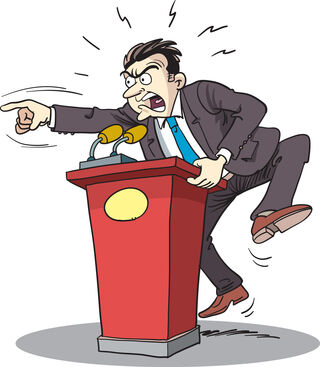Personality
5 Tips for Debating High Conflict People
These tips can be useful in any setting.
Posted September 30, 2020 Reviewed by Ekua Hagan

The recent presidential debate showed what can happen where there is a high-conflict person in any discussion. The tips in this post can be useful in any debate or heated argument, be it in workplace, family, legal, or political settings.
As explained in many of my posts, and in my book, 5 Types of People Who Can Ruin Your Life, a high-conflict person has the following four primary characteristics, which I have been studying for over 20 years:
- A preoccupation with blaming others
- All-or-nothing thinking
- Unmanaged emotions
- Extreme behaviors
This is not a mental health diagnosis, but rather a pattern of conflict behavior. However, many high-conflict people also have a Cluster B personality disorder (narcissistic, borderline, histrionic, or antisocial) or traits. Once you see these primary characteristics, you can predict at least 40 more likely behaviors for the person, such as refusing to reflect on their own behavior, recruiting negative advocates, splitting people into all-good and all-bad, a drive to be the center of attention, a preoccupation with past grievances, responding to requests with unrelated demands, and they usually can’t stop themselves from their high-conflict behavior.
Such high-conflict behavior can be very disconcerting, and most people are so surprised that they respond by mirroring the same behavior in a conflict. I frequently see this in high-conflict court cases. However, there are better ways to respond that we have developed with our High Conflict Institute for coaching individuals and professionals involved in legal disputes, workplace conflicts, and family arguments. Here are five tips for a debate in any setting:
- Don’t take it personally. Remind yourself it’s not about you; it’s about them. Hostile conflict behavior is not designed for problem-solving in the modern world, especially with complex problems like the coronavirus, climate change, and racial equality. Often the high-conflict person is performing in a drama for others, rather than trying to do anything productive. You don’t need to defend yourself—that’s where the trouble begins. Remember, it’s not about you. Instead, do the following:
- Refuse to engage in an emotional confrontation. This can be hard to do, but extremely powerful. “When you are done, I will continue.” You can just stand there or sit there with a confident expression on your face and calm body language until the other person exhausts himself or herself. If there is a moderator or mediator for your debate or discussion, wait patiently while they attempt to rein in the high-conflict person. That way you don’t look rattled and instead look above the fray. The confident and patient facial expression is key to this working, otherwise, you look weak or intimidated, which just feeds a high-conflict person’s aggressive behavior.
- Focus on providing objective information. “You may not be aware of this, but here is some key information on this subject.” This shifts the focus to useful information and shows that you are not getting down in the mud. If/when the high-conflict person interrupts, you return to #2 and wait. Your only responses need to be information focused, which is like pouring cold water on the flames. Do your homework so that you have useful information on every possible subject, but it doesn’t have to be much. All you need is to show that you are informed.
- Ask for the high-conflict person’s proposals for solving problems. Just as in #3, keep the focus on objective information and solutions. You can calmly point out difficulties in their solutions by simply asking, “How would that work? I want to understand.” This helps you look interested in a high-minded discussion without looking intimidated by the high-conflict person.
- Point out the pattern(s) of the high-conflict person’s behavior. This helps observers focus on the high-conflict person and what he or she is really doing. “He is consistently unable to provide any evidence supporting that claim.” “She is just making personal attacks without providing any useful information.” “As you can see, he is unable to control his emotions and stop himself.” “She has a pattern of changing the subject.” “He has a pattern of projection, as his statements fit him more than me, for example..." “As you can see, she is a blamer and not a problem-solver.” “As you can see, he only has one strategy—being a bully. This doesn’t work well in a collaborative society where we need to work together.”
All of these tips could help a reasonable person remain identified with useful information and solutions, heightening the contrast with the high-conflict person looking rather odd or childish with their emotional responses. This is a successful way to train your amygdala in your brain not to get defensive and emotional back. You can’t just white-knuckle it and try not to get defensive. Instead, you can distract yourself from the emotions by focusing on the task of providing information and solutions and asking for information and solutions. This way you can win a debate with a high-conflict person in the eyes of decision-makers who may be watching—and feel good about yourself for staying out of the mud.


